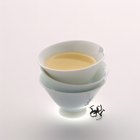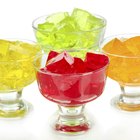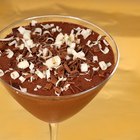The Frosty was one of the original menu items when the first Wendy’s fast-food restaurant opened in 1969. A frozen dairy dessert that is a cross between a milkshake and soft-serve ice cream, the Frosty is now offered in a variety of forms. The Frosty adds significant calories to your meal, but is not completely nutritionally void.
Types
The classic chocolate-flavored Frosty contains milk, sugar, corn syrup, whey, nonfat dry milk and cocoa, along with thickeners and preservatives. The Frosty now comes in a vanilla flavor; a Frosty Float, which involves adding soda to a frosty; the Twisted Frosty, which mixes Oreos, M&Ms or Nestle cookie dough into the dessert; and Frosty milkshakes. In 2009, the Frosty-cino and Coffee Toffee Twisted Frosty were introduced, both of which combine coffee with Frosty flavors and textures.
Calories
The classic Frosty comes in four sizes: junior, small, medium and large. A junior contains 150 calories, a small 310 calories, a medium 410 calories and a large 520 calories. The vanilla flavor contains the same number of calories. The shakes come in small and large sizes and contain 410 and 540 calories, respectively. The Twisted Frosty contains 440 calories, the Frosty-cino has 380 as a small or 510 as a large, and the Float has 390 calories.
Macronutrients
All the Frosty products contain between 7 and 13 g of fat, depending on the size. The vanilla version contains slightly more fat per serving than the chocolate version. Much of the fat in the Frosty is saturated, and the desserts do contain a small amount of trans fats–-a medium or large contains 0.5 g. A large Frosty provides 15 g of protein and 86 g of carbohydrates.
Sugars
Americans eat a lot of added sugar–-355 calories per day, says the American Heart Association. A regular Frosty habit contributes to this overconsumption: A small contains 44 g of sugar and a large has 73 g. Other Frosty variations contain between 53 and 69 g of sugar. Even the junior-sized Frosty contains 22 g of sugar. The American Heart Association recommends Americans take in just 25 to 37 g of added sugar daily.
Considerations
The Frosty does offer a considerable amount of calcium. The large Frosty provides 50 percent of the daily recommended value of this mineral, while a medium offers 40 percent and a small 30 percent. Other Frosty desserts contain between 30 percent and 35 percent of daily calcium needs. Frosty desserts also offer vitamin A: A large has 20 percent of daily recommended needs and a small has 10 percent. Iron is another nutrient in Frosty desserts--between 4 percent and 15 percent of daily recommended values, depending on the size of the dessert.
Related Articles

Low Carb Peanut Butter Snacks

Sugar-Free Coconut Cream Pie

How to Make Gelatin Dessert With Milk

Cappuccino Nutrition Information
Keurig Coffee Nutrition

Brands of Jams & Jellies

Soft Drinks Made With Splenda

Types of Monster Energy Drinks

How to Cook Mini Cheesecakes in Ramekins

What Is Good to Mix With Chocolate ...

What Drinks Can I Make With ...

Starbucks' new dairy-free drink is ...

How Many Types of Chocolate Are There?

How Many Calories Does a Small Banana ...

Fat-Free and Sugar-Free Jell-O Pudding ...

Facts About Yoplait Yogurt

How to Make Chocolate Vodka

What Is the Difference Between a Shake ...

Restaurant Nutrition Guide for Andy's ...

Brownie Bottom Butterscotch Cheesecake ...
References
Writer Bio
Andrea Boldt has been in the fitness industry for more than 20 years. A personal trainer, run coach, group fitness instructor and master yoga teacher, she also holds certifications in holistic and fitness nutrition.